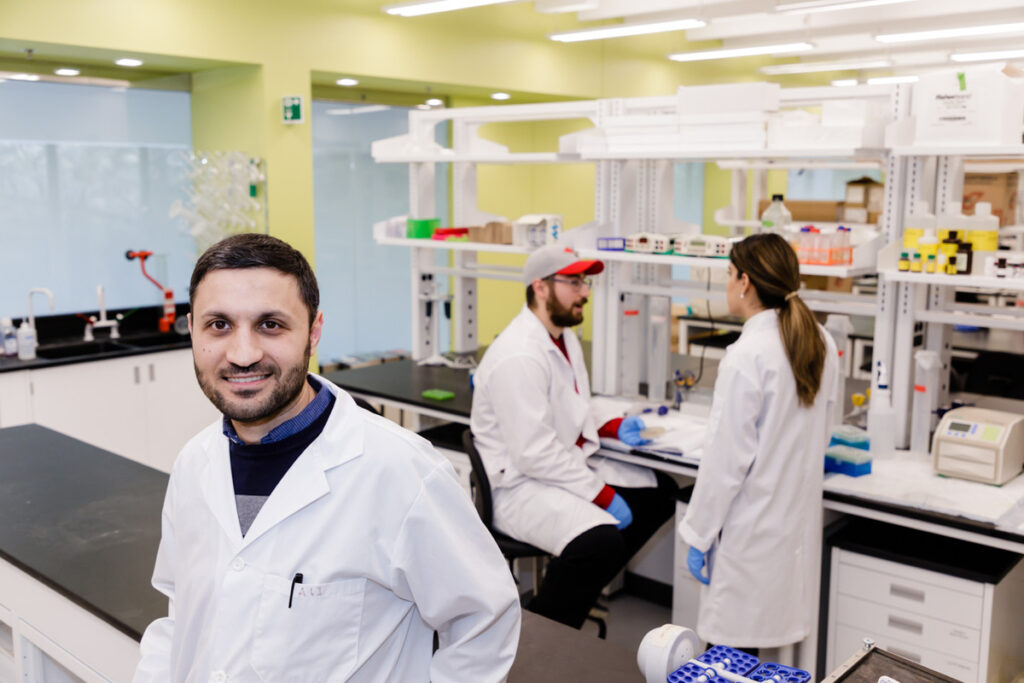Faculty of Health Professor Ali Abdul-Sater’s passion for understanding the body’s immune response has led him to a discovery that he hopes will eventually relieve the suffering of people with rheumatoid arthritis.
By Elaine Smith
Research by Ali Abdul-Sater, a York Research Chair in the Regulatory Mechanisms of Inflammation, and an assistant professor in the School of Kinesiology & Health Science, Faculty of Health, has determined that a specific protein, TRAF1, holds the key to controlling inflammation in rheumatoid arthritis and a specific mutation to the protein can reduce the amount of inflammation the joints experience. With funding from the Canadian Institutes for Health Research, the Arthritis Foundation and York University, Abdul-Sater and his research team are currently testing their findings in mice and hope the results will eventually translate to humans.
“We are planning to use TRAF1 to develop new therapy for rheumatoid arthritis and other inflammatory diseases,” Abdul-Sater says. “I wouldn’t wish rheumatoid arthritis on anyone; it is one of the most painful chronic diseases and it becomes progressively worse. For some sufferers, it can take hours just to get their joints moving each morning.”
Abdul-Sater calls TRAF1 “the Swiss army knife of proteins” because it serves different functions in different immune cells. He discovered that TRAF1 can control or limit inflammation by preventing certain immune cells (macrophages) from producing too many cytokines that destroy the joints; on the other hand, previous research indicated that TRAF1 is also known to activate other immune cells (lymphocytes) and enhance their ability to produce antibodies or cytokines that damage the joints. The key is to find a way to stop TRAF1 from activating lymphocytes while preserving its ability to limit inflammation and cytokine production.

It turns out that TRAF1 is a scaffold, or a platform, from which these signals are sent out. Abdul-Sater found that each of its functions used a different type of scaffold, so he was able to disrupt one function while leaving the other intact. In fact, he discovered a specific genetic mutation that does just that: it prevents immune cells from overproducing antibodies while suppressing its joint-destroying cytokine production, thus reducing inflammation and keeping the joint intact.
Using the CRISPR genetic engineering tool that allows scientists to modify the genes of a living organism, Abdul-Sater and his team are currently creating this mutation in mice to determine whether they are protected from rheumatoid arthritis. If they are, he hopes to move forward toward using this discovery to create therapeutics for people currently living with rheumatoid arthritis.
“We’re not ready yet for interventions in humans,” he says. “Our next step would be to collaborate with medicinal chemists to develop a small molecule that can be taken as a drug and then, hopefully, move on to clinical trials. Drug formulation is a long process. We started from the ground up in finding a way to target this key protein.”
Abdul-Sater says research of this nature requires a real love for the work.
“To stick it out, you have to have passion,” he says. “There are lots of setbacks and long hours, but the reward is the joy of discovering something new and seeing it make a difference in the world.
“I have had excellent support from my department and my Faculty, and I feel lucky to get paid for doing something I love,” he adds.
